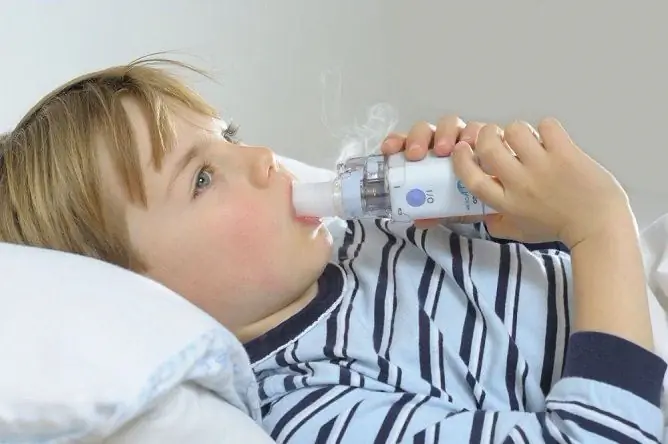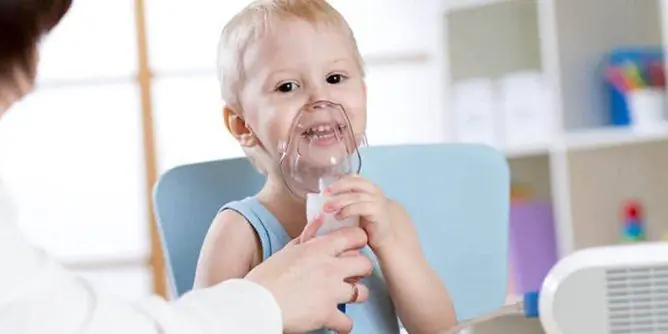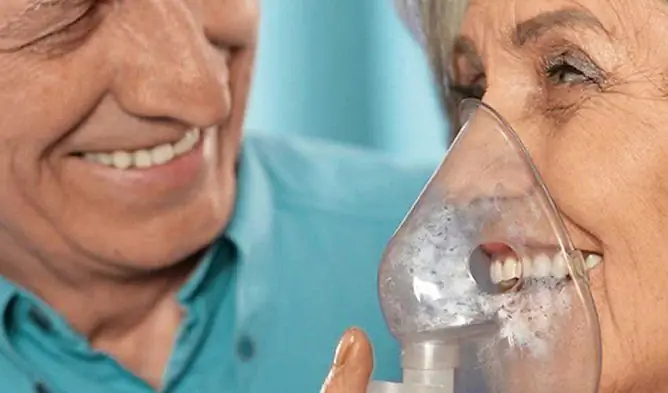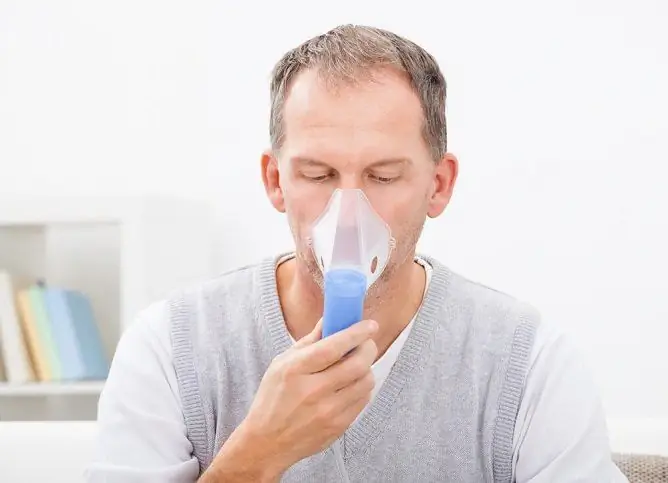- Author Rachel Wainwright [email protected].
- Public 2023-12-15 07:39.
- Last modified 2025-11-02 20:14.
Inhalation for pneumonia with a nebulizer: what is useful, what medications are used
The content of the article:
- What is a nebulizer
- Why inhalation is useful
-
How is inhalation performed
- Training
- Carrying out
- Completion
-
Inhalation medicines
- Antibiotics and antiseptics
- Mucolytics
- Corticosteroids
- Contraindications
- What products can not be used for inhalation
- Video
Inhalation for pneumonia helps to quickly cope with the disease and fully restore lung function in both adults and children.
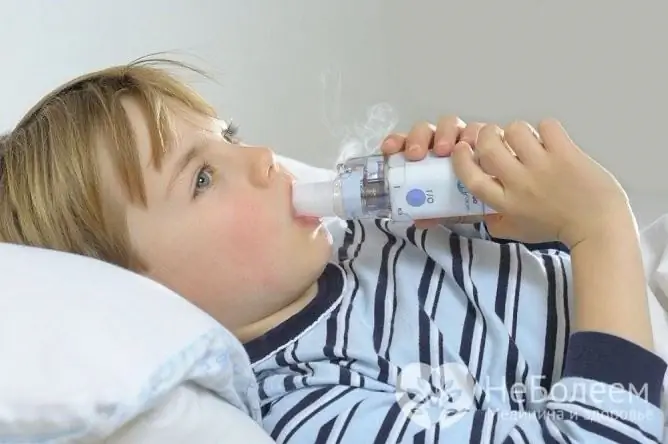
The inhalation method of administration of drugs contributes to the rapid and complete penetration of the active substance into the inflammation focus
Pneumonia (pneumonia) is a serious illness that results from infection, injury, or congestion in the lung tissue. For the treatment of pathology, antibiotics and non-steroidal anti-inflammatory drugs are used in most cases.
A nebulizer is used for inhalation. This is a special apparatus that allows you to process liquid solutions into aerosols. In this case, the medicine itself remains cold, which avoids the development of bronchospasm.
What is a nebulizer
There are two main types of inhalers:
| Inhaler types | Description |
| Compressor | The aerosol in such inhalers is produced by compressed air supplied under pressure into the nebulizer chamber |
| Ultrasonic | The vibration of the piezoelectric element is transmitted to the surface of the solution, where an aerosol cloud is formed |
The most common are compressor nebulizers. The versatility of such a device and a very democratic cost makes it possible to use them at home for the treatment of various respiratory diseases, including pneumonia.
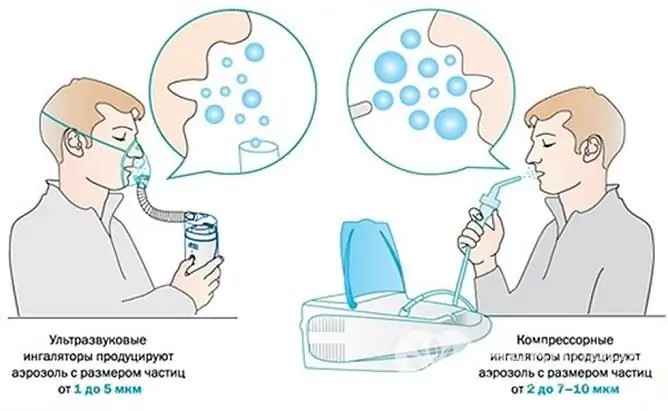
Before purchasing a nebulizer, you need to decide whether it can be used to treat pneumonia
You can buy a nebulizer at a pharmacy. Before buying, you need to pay attention to such an indicator as the size of the molecules into which the drug is converted. With a medium-dispersed type, the formation of particles from 2 to 4 μg is possible, which can penetrate into the lower respiratory tract and affect the inflammatory process.
Why inhalation is useful
Inhalation is used in the complex therapy of the disease. The advantage of this method of administration is that during the procedure, small particles of drugs enter directly into the focus of inflammation. The effect of such treatment is much higher than with the use of drugs inside.
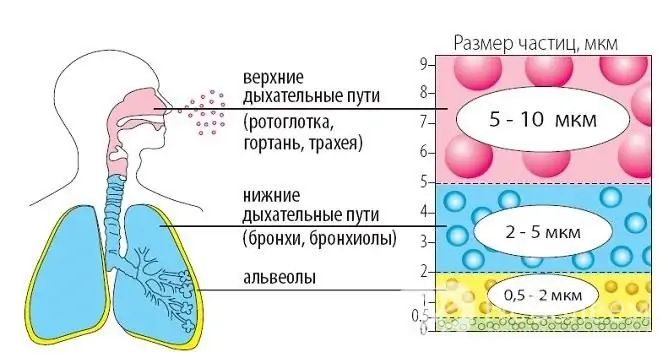
The nebulizer is used to treat not only pneumonia, but also other respiratory diseases
Also, the inhalation method of administration of drugs is used to treat bronchitis, tracheitis, laryngitis, pharyngitis.
Since the active substances of the drug do not pass through the gastrointestinal tract, acids and enzymes do not affect them, which allows you to fully preserve the pharmacological properties and avoid the development of side effects from the digestive system.
Inhalation with pneumonia with a nebulizer helps to cope with the disease faster, while they are painless and safe. They allow you to accelerate the discharge of sputum, reduce inflammation and remove edema. Moisturizing the mucous membranes helps to accelerate their regeneration and recovery.
How is inhalation performed
Training
The procedure is carried out one and a half hours after eating or exercising. It is not recommended to use expectorants or gargle with antiseptics less than an hour before inhalation.
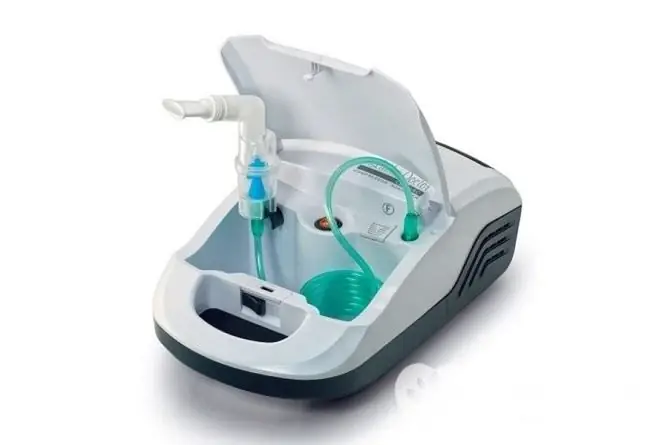
Before carrying out the procedure, you need to prepare for it.
The inhaler is prepared for work: it is plugged into an outlet and the medicine is placed in a special container.
Carrying out
The procedure is carried out for 3-15 minutes, depending on the amount of solution, the age of the patient and the power of the nebulizer. In order for the agent to penetrate deeply into the respiratory tract, use a mouthpiece, not a mask.
Completion
After the end of the procedure, the remaining solution is drained, and the parts of the device are washed with boiled water, disinfected and dried. It is not recommended to eat for an hour or leave a warm room to the street.
Inhalation medicines
If the doctor prescribes several medicines for inhalation, they cannot be used simultaneously. There should be at least 15 minutes between treatments. First, drugs are used that expand the bronchi, then mucolytics, and only at the next stage are anti-inflammatory drugs used.
It must be remembered that only 0.9% sodium chloride solution or distilled water (water for injection) is used to dilute the inhalants. In no case should ordinary boiled water be used, as this can cause bronchospasm. Only sterile solutions can be poured into the nebulizer.
Antibiotics and antiseptics
The following drugs are used to treat pneumonia:
- Fluimucil-antibiotic IT. It is the only drug that combines a broad-spectrum antibiotic (thiamphenicol) and a mucolytic (acetylcysteine). The tool is available in the form of a powder, which is dissolved in saline before use. The finished product can be stored for no more than a day;
- Tobramycin (Bramitob). The drug belongs to the group of antibacterial glycosides. It is used to treat chronic lung diseases caused by Pseudomonas aeruginosa;
- Dekasan. Antiseptic agent containing decamethoxin. The drug has antibacterial, antifungal and antiviral effects. It is also active against antibiotic-resistant microorganisms. Dekasan for inhalation is diluted with saline in a 1: 1 ratio.
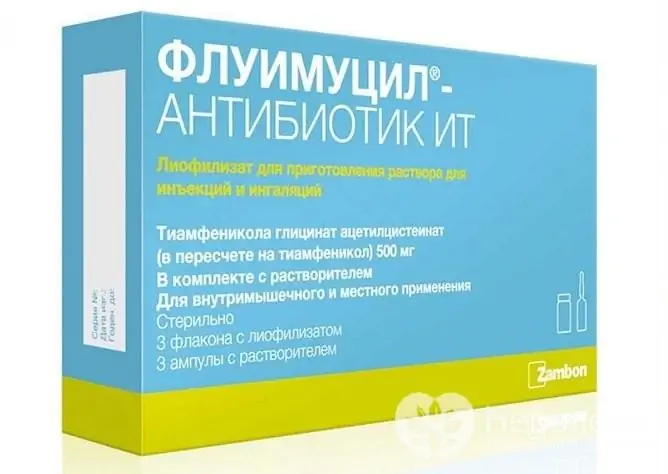
Fluimucil-antibiotic IT is a combined agent containing an antibiotic and a mucolytic
Mucolytics
In the complex treatment of pneumonia, mucolytics are used . They thin the phlegm and promote its excretion without increasing its amount. The most popular and effective remedies include:
- Lazolvan (Mukolvan, Mukosol). The active ingredient of these drugs is ambroxol hydrochloride. The products thin and flush mucus, thus relieving coughing. They also have anti-inflammatory and mild analgesic effects. When using ambroxol, the concentration of antibiotics in the blood, sputum and bronchopulmonary secretions increases. Lazolvan for inhalation is diluted with saline in a ratio of 1: 1. 1-2 procedures can be performed per day;
- Acetylcysteine (Ingamist). These drugs are classified as mucolytic agents. They dilute phlegm well, eliminating the viscosity of mucus, and are active even in the presence of purulent phlegm. They are prescribed for acute and chronic respiratory diseases. Before use, they are diluted in a 1: 1 ratio with water for injection.

Mucolytics, including Lazolvan, facilitate the elimination of phlegm
Corticosteroids
The drugs in this group have a pronounced anti-inflammatory effect. They are used for obstructive respiratory diseases. In the complex treatment of pneumonia, they use:
- Pulmicort (Budesonide, Benacort). These drugs are anti-inflammatory, relieve bronchospasm and improve lung function. Unlike corticosteroids, which are taken orally or are injected, these drugs are practically not absorbed into the bloodstream and do not have a systemic effect;
- Berodual. The active ingredient of the drug is fenoterol hydrobromide. Berodual is a bronchodilator and allows you to expand the lumen of the respiratory system during the period of bronchial obstruction, as well as relieve spasm of smooth muscles. The drug has a mild anti-inflammatory effect.
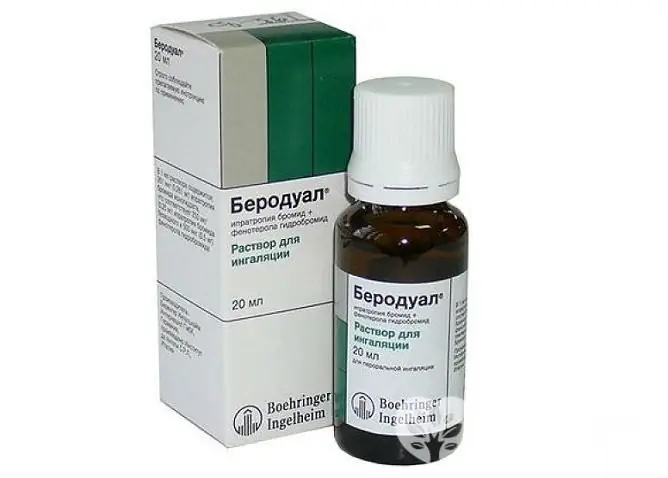
As part of a complex treatment, corticosteroids can be used, for example, Berodual
Contraindications
Despite the fact that inhalations are quite safe, they are not recommended in the following cases:
- increased body temperature (above 37.5 ° C);
- the presence of purulent inflammation in the nasopharynx;
- tendency to nosebleeds;
- heart failure;
- high blood pressure;
- tumors in the lungs;
- pulmonary tuberculosis.
Also, a contraindication to the procedure is the presence of such a symptom of pneumonia as blood or pus in sputum.
What products can not be used for inhalation
Essential oils and oil solutions cannot be used for inhalation with pneumonia. Despite the fact that pine, fir or eucalyptus oil is used for warm-humid inhalations for respiratory diseases, they must never be poured into a nebulizer.

Essential oils cannot be used for inhalation using a nebulizer
Breaking into small droplets under the pressure of the air flow, they lie in an even layer on the small bronchi, as a result of which they become blocked. This can lead to impaired gas exchange and pulmonary edema. If you do not provide medical assistance to a person in a timely manner, a lethal outcome is possible.
Also, do not use for inhalation:
- solutions and suspensions containing suspended particles;
- decoctions and infusions of medicinal herbs;
- Platyphyllin, Diphenhydramine, Euphyllin.
Inhalation with pneumonia at home contributes to the speedy recovery and restoration of the functions of the respiratory system. But you should not prescribe this procedure yourself, you must first consult with your doctor.
Video
We offer for viewing a video on the topic of the article.

Anna Kozlova Medical journalist About the author
Education: Rostov State Medical University, specialty "General Medicine".
Found a mistake in the text? Select it and press Ctrl + Enter.

